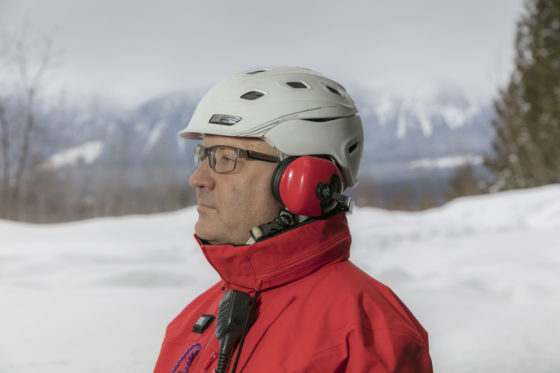Summer is a good time for heli-ski guides to figure out the best hearing protection for wearing with helmets to minimize exposure to hazardous noise levels.

Photo credit: © WorkSafeBC (Workers’
Compensation Board), used with permission
Heli-ski guides have many things to keep in mind when it comes to safety – one of which is how to protect their hearing.
Most of heli-ski guides’ exposure to hazardous noise levels (above 85 decibels) occurs when they’re inside the helicopter and when they’re loading and unloading it. This means they need to use hearing protection while they’re in or near the helicopter, but not while they’re skiing with their clients.
“Anyone who’s in or around helicopters and doing a few trips a day is going to be exposed to hazardous noise levels very, very quickly,” says WorkSafeBC audiologist Sasha Brown. “For a heli-guide – or any ski guide in the back country – the ability to hear well is very important. They need to be able to hear their clients. And there’s a lot of safety information they get from the sounds and textures of the snow. It’s important that they protect their hearing so they can hear these sounds.”
See much more information on this topic in Hearing protection for heli-ski guides, a new bulletin from WorkSafeBC.
The helmet and hearing protection dilemma
Heli-ski guides are also required to wear helmets. But since some types of hearing protection are awkward or uncomfortable to use with a helmet, some guides end up choosing not to wear hearing protection.
“This is a pretty difficult industry for hearing protection because guides often have big mitts on, so they’re not able to compress ear plugs and insert them,” Sasha says. “It’s cold, so a lot of stuff becomes brittle or uncomfortable.”
She adds that many guides saw it as an an “either-or” situation and felt they couldn’t wear their helmets and their hearing protection at the same time. The result was that hearing protection wasn’t being worn.
Studying noise exposure using tiny in-ear microphones
Heli-Cat Canada (an association that represents the helicopter and snowcat skiing industry) approached WorkSafeBC to find solutions for this conundrum. Some guides were using helmets with ear flaps, and they wanted to test how effective this was. Researchers placed tiny microphones in guides’ ear canals and on their shoulders, then tested noise levels of four different types of helicopters. What was the result? Ski helmets with ear flaps don’t provide any hearing protection.
The Heli-Cat study also explored at these other questions:
- Are heli-ski guides exposed to levels of noise that can damage hearing? (Answer: Yes.)
- Is it effective to use over-the-ear hearing protection in combination with helmets, thin balaclavas, and toques? (Answer: It depends)
- What is the overall effectiveness of several brands of ear-muff style hearing protection?
You can see the full report for detailed findings. Essentially, it recommends that guides use over-the-ear muffs with thin toques or balaclavas. They should avoid wearing thicker headwear under a helmet because that can limit the earmuffs’ effectiveness.


